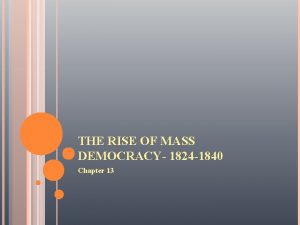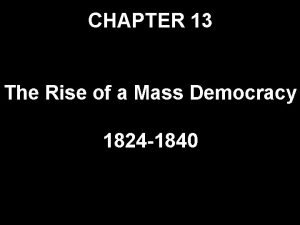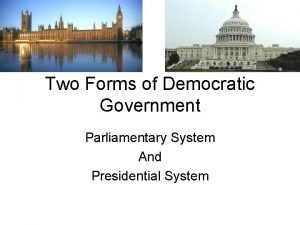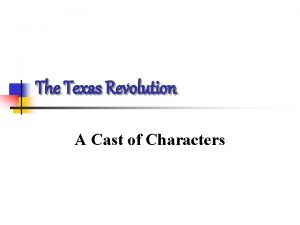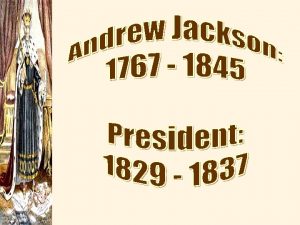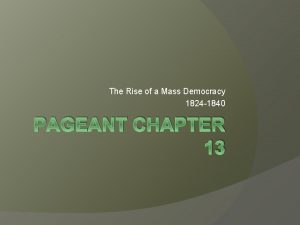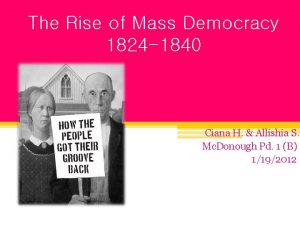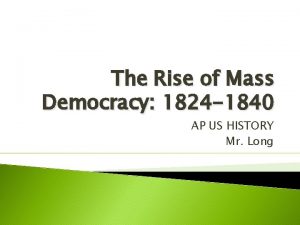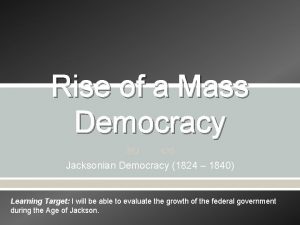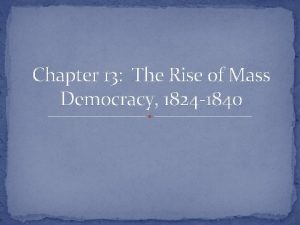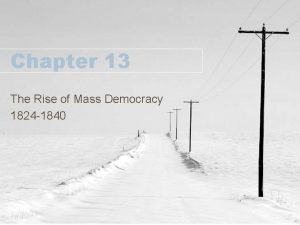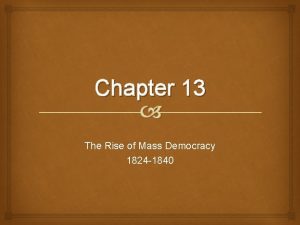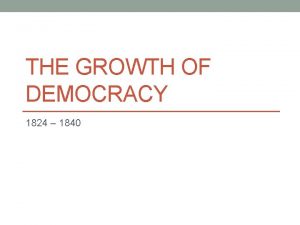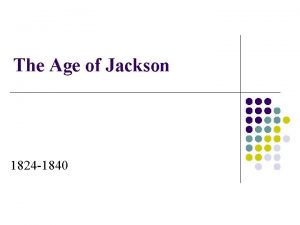Ch 13 Rise of Mass Democracy 1824 1840














- Slides: 14

Ch 13 – Rise of Mass Democracy 1824 -1840 Jackson Goes to “War”

VIII. The Trail of Tears A. Expansion west meets Native Americans 120, 000 Native Americans still live east of Mississippi River in 1820 Most were recognized as separate nations whose land should be bought fairly in treaties (a precedent established by Washington’s administration). White settlers encroached constantly; many treaties ignored B. Assimilation efforts Many sought to “civilize” and “Christianize” the natives Congress appropriated $20, 000 for Indian literacy programs Many missionaries head west

C. The Cherokee While many resisted, the Cherokee adopted white ways Agricultural society with an alphabet, code of laws, constitution, newspaper, private property, even slave ownership One of the “Five Civilized Tribes”, including: Creek, Chickasaw, Choctaw, & Seminole D. Worcester v. Georgia GA seeks to appropriate Indian land for its own uses Cherokee sue state of GA; case heard by US Supreme Court John Marshall rules in favor of Cherokee to keep lands President Jackson ignores the ruling & sends troops anyway “John Marshall has made his decision - - now let him enforce it. ”

E. Trail of Tears “Voluntary” removal under chaperone of federal troops was “for their own good”, as peace & safety could be assured west of the Mississippi 1830 – Indian Removal Act passes Congress 100, 000 Indians relocated to Indian Territory “reservations” in OK 5, 000 + die along route, mostly elderly, women, & children 1836 – Bureau of Indian Affairs created to manage native relations F. Wars of resistance 1832 – Black Hawk War sees Sauk & Fox tribes of IL & WS crushed by federal troops 1835 -1842 – Seminole Wars in FL sees bloody guerilla fighting in Everglades swamps Leader Osceola captured under flag of truce; 80% of Seminoles forced west


w. Knowledge Checkpoint 1 1. What is assimilation, and why was it desired as a policy for the Native Americans? 2. How did Jackson and the Supreme Court differ on the Cherokee’s claims to their lands? 3. What was the final destination for tribes on the Trail of Tears, and why? NEXT…Jax goes to war against “big money” vowing to “fiddle with Biddle” cuz his “bank done stank. ”

IX. The Bank War A. Jackson vs. the B. U. S. “monster” The B. U. S. minted silver/gold coins, controlled stable paper notes; very useful to fed. gov’t Private institution accountable not to public, but to its own elite investors B. U. S. president Nicholas Biddle very powerful Many objected to its priorities of profit over public service, particularly when it foreclosed on many Westerners’ homes/farms B. The charter scheme 1832 – Jax haters Daniel Webster & Henry Clay push bill to re-charter B. U. S. 4 yrs early (B. U. S. charter not set to expire until 1836) Clay wanted it to be a major election issue when he faced off against Jackson’s re-election bid Clay expected Jax to veto it and thus anger the wealthy classes of the East

C. The plan backfires Jackson vetoes the bill, claiming the B. U. S. to be unconstitutional (technically not true – a previous Supreme Court case had validated it) Jackson: “The BUS is trying to kill me…but I will kill it. ” Unprecedentedly powerful veto action showed strength of President’s office Westerners hail Jax as a “hero” of the people; Clay misjudges public mood

X. “Old Hickory” Wallops Clay in 1832 A. Strong support / heated opposition Jacksonian Democrats loyal as ever, pushing Jax to seek 2 nd term Clay’s National Republicans joined by Anti-Mason party as Jax opponents 1832 – 1 st election to have national conventions publicly name candidates 1832 – 1 st election to have candidates develop policy platforms (campaigning on the issues they feel strongly about) B. Clay overconfident National Republican party well-funded $50, 000 loaned by B. U. S. to campaign Newspapers in Clay’s pocket; attack Jackson in headlines daily

C. Lopsided victory Jackson wins popular vote significantly Beats Clay 219 -49 in electoral vote

XI. Burying Biddle’s Bank A. Jax kills the B. U. S. 1833 – Jax decides to withdraw all federal deposits from B. U. S. Wants to dry it up of resources Wants to prevent Biddle’s plans for re-chartering B. U. S. B. A shrewd play pans out Jax’s approach of siphoning money complicated, vindictive, and some believed unnecessary and unconstitutional Jax shuffles Cabinet members to find Sec. of Treasury who will follow through with plan Biddle recalls all loans in last effort to keep B. U. S. afloat Many banks/investors default on their loans; B. U. S. out of resources

C. Pet banks Jax spreads federal funds into smaller state banks, nicknamed his “pet banks” or “wildcat banks” Many of these banks are small-time operations; gov’t now lacks a stable go-to banking institution (B. U. S. formerly served such a role) Economy grows unstable D. Panic of 1837 Wildcat banks are loose with loans & overprint paper money, causing widespread inflation Jax authorizes Treasury to issue Specie Circulae – meaning land can only be purchased with coin money, not paper Sudden money transition leads to financial crash; banks close, businesses fail, jobs lost Jackson out of office by the time this Panic of 1837 sets in

w. Knowledge Checkpoint 2 4. Who was Jackson’s chief political opponent, and what tactic did he use to try to discredit Jackson? 5. How did Jackson end the existence of the Bank of the United States, and why did he do so? 6. What was the final outcome of Jackson’s bank restructuring by 1837? NEXT…Jackson runs for president a 3 rd time, knowing the loyalty of his rabid bands of followers and his own personal superhuman “hickory-wood” strength will prove vital in the impending zombie apocalypse.

The End
 Chapter 13 the rise of a mass democracy
Chapter 13 the rise of a mass democracy Election of 1836 & rise of mass democracy
Election of 1836 & rise of mass democracy Chapter 13 the rise of a mass democracy
Chapter 13 the rise of a mass democracy Presidential form of government
Presidential form of government A union b example
A union b example Rise and rise again until lambs become lions
Rise and rise again until lambs become lions Tricky dick
Tricky dick Raise and rise again until lambs become lions
Raise and rise again until lambs become lions The age of jackson 1824-1844
The age of jackson 1824-1844 Juan seguin character traits
Juan seguin character traits Was andrew jackson a president
Was andrew jackson a president Constituição 1824
Constituição 1824 Austin
Austin Romantic period 1798 to 1832
Romantic period 1798 to 1832 The romantic age (1798 to 1824)
The romantic age (1798 to 1824)

